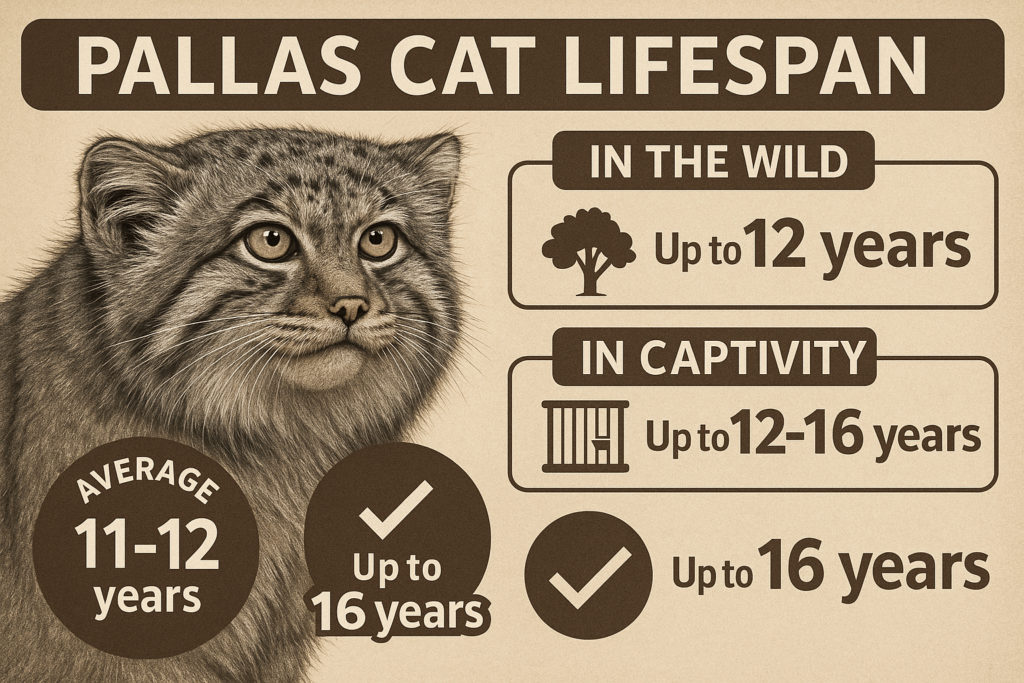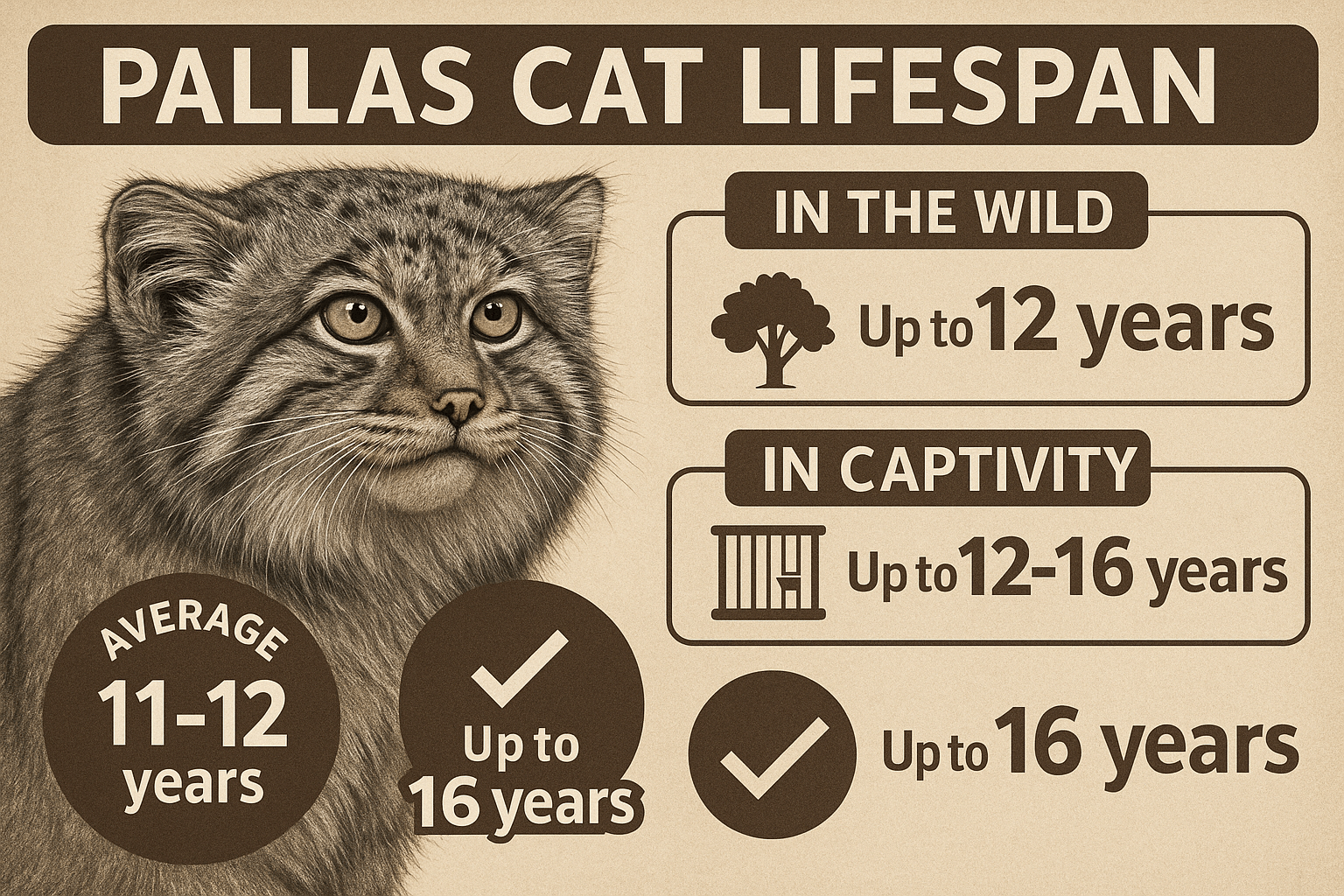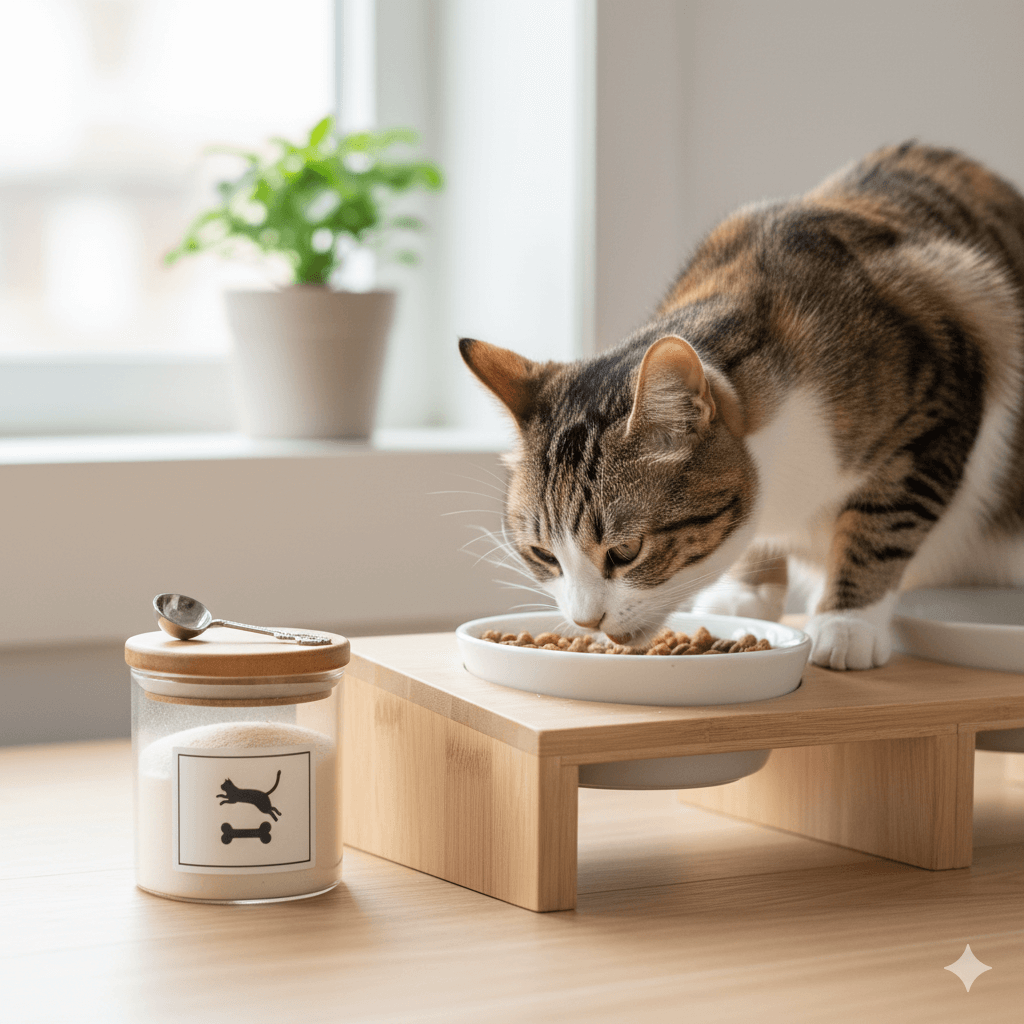Pallas Cat Lifespan: How Long Do These Unique Felines Live?
The Pallas cat, also known as Otocolobus manul, is one of the most fascinating feline species in the world. With its stocky build, thick fur, and expressive eyes, this elusive wildcat has captured the hearts of wildlife enthusiasts globally. But how long do these adorable yet mysterious creatures live? Understanding the Pallas cat lifespan involves exploring their natural habitat, challenges they face in the wild, and efforts to protect them in captivity. In this blog post, we’ll dive into the factors that influence their longevity and uncover what makes these cats so special.
Factors Influencing the Pallas Cat Lifespan
The lifespan of a Pallas cat can vary significantly depending on several environmental and biological factors. Here’s a closer look at what influences how long these unique felines live.
Habitat and Environment:
Pallas cats thrive in cold, arid regions like the steppes and grasslands of Central Asia. Harsh climates can affect their survival rates, especially during extreme winters.Predators and Threats:
Natural predators such as eagles, wolves, and foxes pose significant risks to Pallas cats, particularly young or vulnerable individuals.Dietary Challenges:
Their diet primarily consists of small rodents and birds, but food scarcity during certain seasons can impact their health and longevity.Human Activities:
Habitat destruction, poaching, and accidental trapping by humans have contributed to declining populations, affecting their average lifespan.Health Issues in the Wild:
Parasites, diseases, and limited access to medical care in their natural habitats can shorten their lives compared to those in captivity.
Understanding these factors helps conservationists create strategies to improve the survival rates of Pallas cats both in the wild and under human care.

Pallas Cat Lifespan in Captivity vs. the Wild
The lifespan of a Pallas cat differs greatly depending on whether it lives in the wild or in captivity. Let’s break down the key differences between these two environments.
Lifespan in the Wild:
On average, Pallas cats live about 6 to 8 years in the wild due to harsh conditions, predation, and limited resources.Lifespan in Captivity:
In zoos or wildlife sanctuaries, where they receive proper nutrition, veterinary care, and protection from predators, their lifespan can extend up to 12 years or more.Controlled Diet and Nutrition:
Captive Pallas cats benefit from balanced diets tailored to their needs, reducing the risk of malnutrition-related illnesses.Protection from Predators:
Living in secure enclosures eliminates threats from larger animals, allowing them to live longer without constant danger.Medical Care and Monitoring:
Regular check-ups and treatments for parasites or diseases help extend their lives significantly compared to their wild counterparts.
These comparisons highlight the critical role that conservation efforts play in ensuring the well-being and longevity of Pallas cats.
Check this guide 👉Scottish Fold Munchkin Cat Lifespan: Best 7 Expert Tips!
Check this guide 👉Understanding the Sphynx Cat Lifespan: Best 7 Expert Tips!
Check this guide 👉Burmese Cat Lifespan: Best 7 Expert Tips!
Challenges in the Wild | Advantages of Captivity |
|---|---|
Harsh weather conditions | Climate-controlled environments |
Scarcity of prey | Consistent access to nutritious food |
Threats from predators | Safe, predator-free enclosures |
Limited medical care | Routine veterinary check-ups |
Habitat destruction by humans | Protected spaces dedicated to conservation |
Conservation Efforts to Extend the Pallas Cat Lifespan
Protecting the Pallas cat requires collaborative efforts from governments, organizations, and individuals worldwide. These initiatives aim to safeguard their habitats and improve their chances of survival.
Establishing Protected Areas:
Creating reserves and national parks ensures safe havens for Pallas cats to thrive without human interference.Anti-Poaching Campaigns:
Strict laws and awareness programs discourage illegal hunting and trapping of these rare felines.Research and Monitoring:
Scientists study Pallas cat behavior, genetics, and ecology to develop better conservation strategies tailored to their needs.Community Engagement:
Educating local communities about the importance of Pallas cats fosters coexistence and reduces conflict with humans.Breeding Programs in Zoos:
Captive breeding programs help maintain healthy populations while raising public awareness about the species’ plight.
Through these efforts, conservationists hope to secure a brighter future for Pallas cats and extend their lifespans in the wild.
Fun Facts About Pallas Cats and Their Lifespan
Beyond their lifespan, there are many intriguing aspects about Pallas cats that make them stand out among other feline species. Here are some fun facts you might not know!
Unique Appearance:
Their flat faces, round ears, and dense fur give them an unmistakable look that sets them apart from domestic cats.Adaptability to Cold Climates:
Their thick fur and bushy tails help them survive freezing temperatures, which impacts their ability to endure tough environments.Solitary Nature:
Pallas cats are solitary animals, preferring to live alone except during mating season, which may influence stress levels and overall health.Camouflage Skills:
Their grayish fur blends perfectly with rocky terrains, helping them evade predators and live longer in the wild.Slow Reproduction Rate:
Female Pallas cats give birth to small litters, typically only 2-6 kittens per year, which affects population growth and recovery rates.
These quirky traits add depth to our understanding of Pallas cats and emphasize the need to protect their fragile existence.
Common Misconceptions About Pallas Cats
Despite growing interest in Pallas cats, misconceptions about them persist. Clearing up these myths helps us better understand and appreciate these fascinating creatures.
They Are Not Domestic Cats:
Many people mistake Pallas cats for oversized housecats, but they are wild animals with distinct behaviors and needs.Their Fluffy Fur Doesn’t Mean They’re Cuddly:
Their thick coats are designed for insulation, not affection—they are solitary and prefer minimal interaction.They Don’t Roar Like Big Cats:
Unlike lions or tigers, Pallas cats communicate through growls, hisses, and mews, similar to smaller felines.They Aren’t Lazy Hunters:
Although they appear slow-moving, Pallas cats are skilled ambush hunters adapted to stalking prey in rugged terrain.They Aren’t Abundant in Numbers:
Despite their wide range, their low population density makes them vulnerable to extinction.
Dispelling these misconceptions fosters greater appreciation and respect for Pallas cats.
The Role of Diet in Pallas Cat Longevity
A Pallas cat’s diet plays a crucial role in determining its lifespan. Understanding their nutritional needs sheds light on their overall health and survival.
Primary Food Sources:
Small rodents like pikas and voles form the bulk of their diet, providing essential fats and proteins.Seasonal Variations:
During winter months, food scarcity forces them to adapt, impacting their physical condition and longevity.Importance of Hydration:
Living in dry regions means water sources are scarce; they rely heavily on moisture from their prey.Impact of Malnutrition:
Poor diets in the wild lead to weakened immune systems, making them more susceptible to illness.Captive Diets Enhance Health:
In zoos, carefully planned meals mimic their natural diet, improving their quality of life and extending their lifespan.
Proper nutrition is key to ensuring Pallas cats remain healthy and resilient throughout their lives.
Adapting to Climate Change
Climate change poses new challenges for Pallas cats, threatening their habitats and survival. Learning how they adapt—or struggle—can guide conservation strategies.
Shifting Habitats:
Rising temperatures alter their native ecosystems, forcing them to relocate or face unsuitable conditions.Increased Human Encroachment:
Melting snowlines and expanding agriculture bring humans closer to Pallas cat territories, increasing conflicts.Changing Prey Availability:
As rodent populations decline due to climate shifts, Pallas cats must find alternative food sources, impacting their health.Extreme Weather Events:
More frequent storms and droughts exacerbate already harsh living conditions, testing their resilience.Conservation Innovations:
Researchers are developing adaptive strategies, such as artificial shelters and supplemental feeding, to mitigate climate-related threats.
By addressing these challenges, we can help Pallas cats adapt to a rapidly changing world and secure their place in it.
Frequently Asked Questions About Pallas Cat Lifespan
How long does a Pallas cat live in the wild?
In the wild, Pallas cats generally live around 6 to 8 years due to environmental challenges.
Can Pallas cats live longer in captivity?
Yes, in captivity, they can live up to 12 years or more thanks to better living conditions and medical care.
What threatens the survival of Pallas cats?
Predators, habitat loss, climate change, and human activities all contribute to their declining populations.
Are Pallas cats endangered?
While not critically endangered, they are classified as “Near Threatened” due to ongoing conservation concerns.
How can I support Pallas cat conservation?
Supporting wildlife organizations, spreading awareness, and advocating for sustainable practices can make a difference.
Securing a Brighter Future for Pallas Cats
The Pallas cat’s lifespan reflects the delicate balance between nature and human intervention. Whether in the wild or in captivity, these remarkable felines face numerous challenges that require our attention and care. By supporting conservation efforts, respecting their habitats, and learning more about their unique characteristics, we can ensure that future generations will continue to marvel at the beauty of Pallas cats. Let’s work together to give these shy, fluffy felines the long, healthy lives they deserve.
Understanding Bone Supplement for Cats: Best 7 Expert Tips! – Safe, vet-approved guidance for strong feline bones & balanced nutrition.
Bone Supplement for Dogs: Best 7 Expert Tips! – Expert guide to calcium, collagen & bone health for every life stage.
Understanding Can Cats Get Sunburn: Best 7 Expert Tips! – Protect your feline from UV damage with vet-backed prevention strategies.
How to Train a Seizure Alert Dog: Best 7 Expert Tips! – Learn expert-backed steps to nurture natural instincts into reliable, life-saving seizure alerts.





